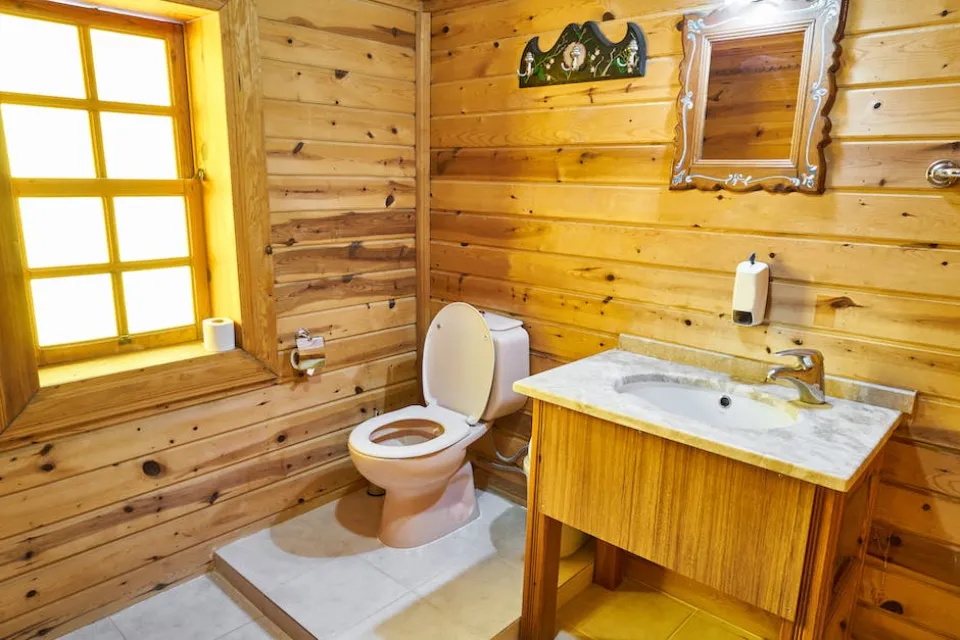In the kitchen, a clogged sink can be a nightmare. The good news is that clearing a clogged drain is very simple. So, how to unclog a kitchen sink?
To start with, you need to Check the Garbage Disposal. Then, there are a few methods how to unclog a kitchen sink, such as removing the clog by hand, using a plunger, using boiling water, or using a coat hanger…
Continue reading.
How to Unclog a Kitchen Sink?
Here’s how to easily unclog the buildup in your kitchen sink pipes.
Check the Garbage Disposal
One of the first things you should do if your kitchen sink is clogged is tounclog the garbage disposal. To see if the clogged drain is cleared, run the disposal for a few minutes while the hot water is running. If that doesn’t solve the problem, make sure the disposal is off and give it a thorough inspection to make sure it’s operating properly.
If the disposal has overheated and automatically switched off, you may need to restart it at the base. The base “on/off” switch can usually be found on the side or bottom of the disposal unit underneath the sink.
Remove the Clog by Hand
Try to get a good look inside the drain using a flashlight, if you can. An obstruction may occasionally be plainly noticeable and reachable close to the surface. Do your best to remove the obstruction while wearing a pair of rubber gloves.
Use a Plunger
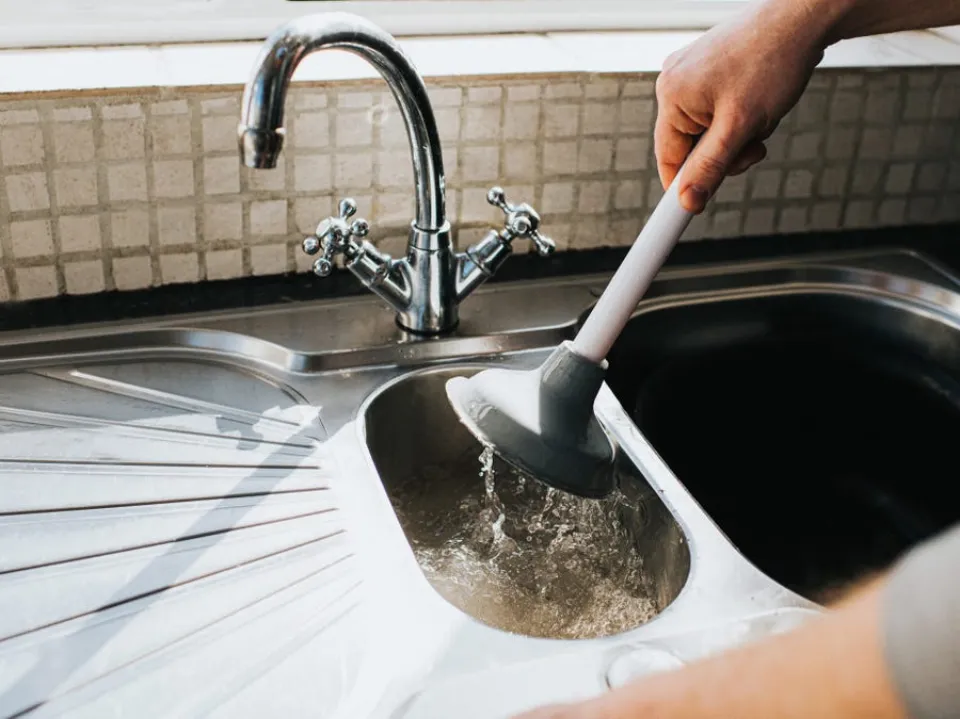
Fill the sink partially full of hot water. Until it is 1/4 to 1/2 full, fill the sink with water.
Put the plunger in the drain’s opening. If you have a double sink, place a washcloth in the drain that isn’t clogged to direct the plunger’s pressure toward the obstruction.
Work the plunger up and down quickly. Check to see if the water starts to drain after you remove the plunger from the drain opening.
Once the clog has been released, keep using the plunger. Dislodging the obstruction might take some time. Try another approach if this one doesn’t work.
Use Boiling Water
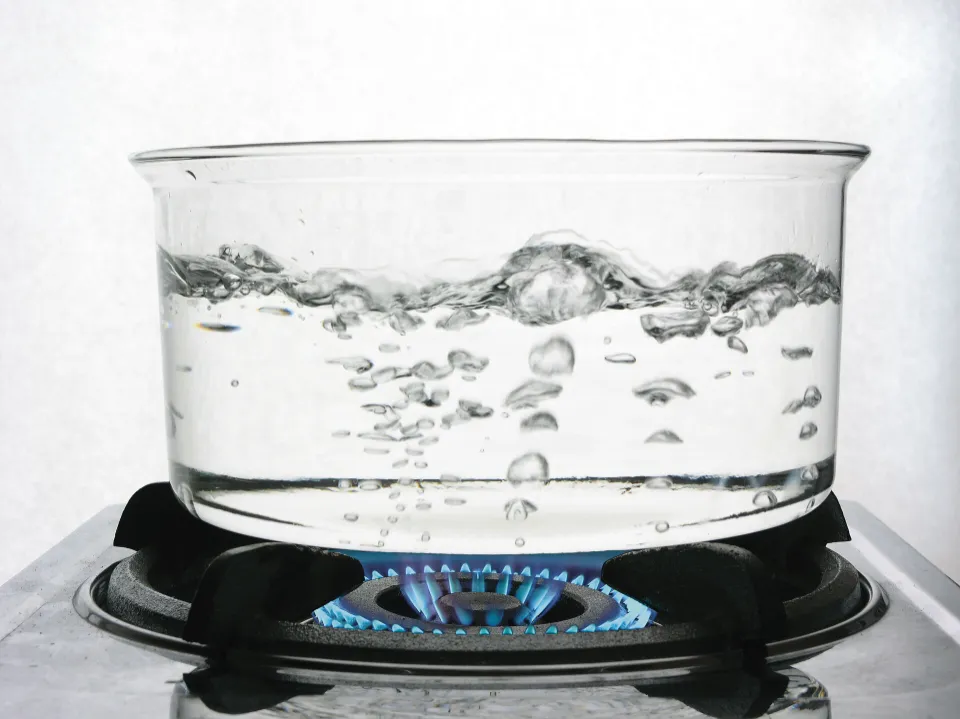
With one or two good blasts of extremely hot water, a clogged kitchen sink can frequently be cleared. (If there isn’t any water standing in the sink already, this will work best.)
Step 1: Bring water to a boil in a big pot on the stove.
Step 2: Carefully pour water down the drain to loosen or break up the clog.
Step 3: Check the drain once more and repeat as required.
Use Items in Your Pantry as a DIY Drain Cleaner
Unclogging your kitchen sink doesn’t always require using harsh cleaners, did you know? A natural drain cleaner might be waiting for you in the kitchen. Here are some ideas:
- Utilize salt and piping hot water. Sometimes you can unclog a drain with salt. Pour about half a cup of table salt down the drain after getting rid of as much standing water from the sink as you can. Then, pour in about a quart of boiling water. After a short while, flush with hot water to clear the mixture.
- Try making your own vinegar and baking soda drain cleaner. Before attempting this technique, empty the sink of any standing water. A cup of baking soda and an equal amount of white or apple cider vinegar should be poured into the drain. Soon the solution will begin to bubble; when it stops, insert the stopper and wait for about 15 minutes. Check to see if the clog clears after running the hot water. Repeat the process one more time if the water is draining but slower than normal (that means the clog isn’t fully clear yet).
- Salt and baking soda are used. Pour one cup of baking soda and one and a half cups of salt down the drain. The mixture should be left to sit for several hours before being flushed with boiling water. You can repeat this process if it doesn’t clear the clog.
Use a Coat Hanger
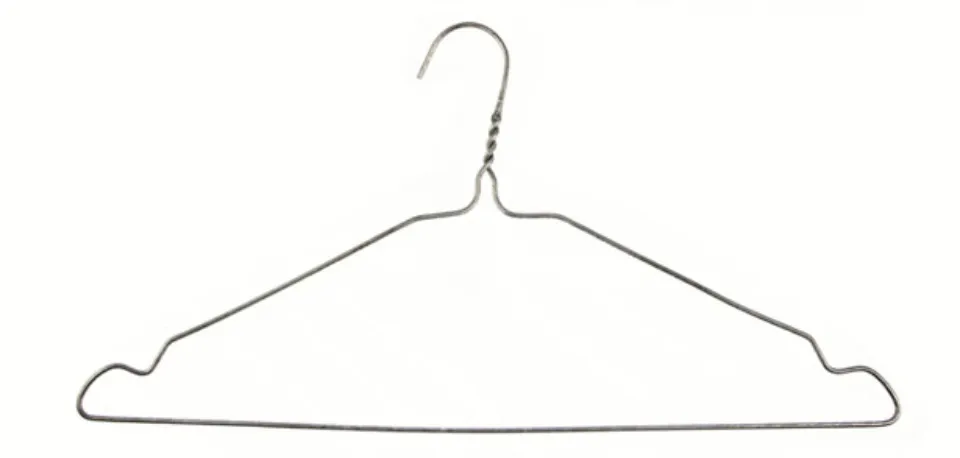
A wire coat hanger can be a great tool if your kitchen sink is clogged. It won’t reach into your kitchen sink plumbing as far as a plumber’s snake would, but it may be long enough to reach some clogs.
Insert the straightened hanger wire into the kitchen drain or “stub pipe” to push through or pull out the clog if you can reach it. Make sure the wire doesn’t scratch your sink.
You may also want to invest in a plastic drain clog remover tool to help get rid of the gunk. This device is intended to help you get rid of hair from a shower or sink that drains slowly, but you can also use it to catch obstinate food particles in a kitchen sink that is clogged. Simply be careful to move slowly and gently because the thin plastic can break off and lead to more issues.
Try a Plumber’s Snake
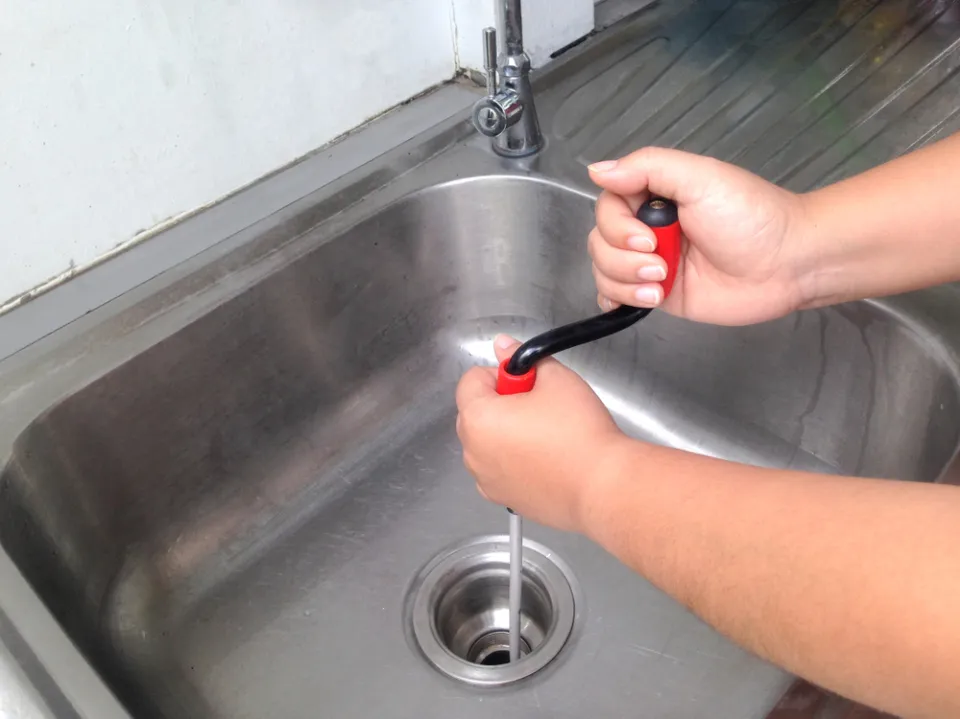
If the coat hanger didn’t work, head to the hardware store and purchase a plumber’s snake. A plumber’s snake, which is also known as an auger, is a useful instrument that can unclog clogs lodged deeper within the drainage system beneath your kitchen sink.
You’ll have to disassemble the drainpipe and P-trap that runs underneath the kitchen sink to expose the “stub pipe” or “stub out” that travels behind the cabinet wall. To remove the clog, insert the snake into the pipe at this point and continue until you encounter resistance.
Clean the P-trap
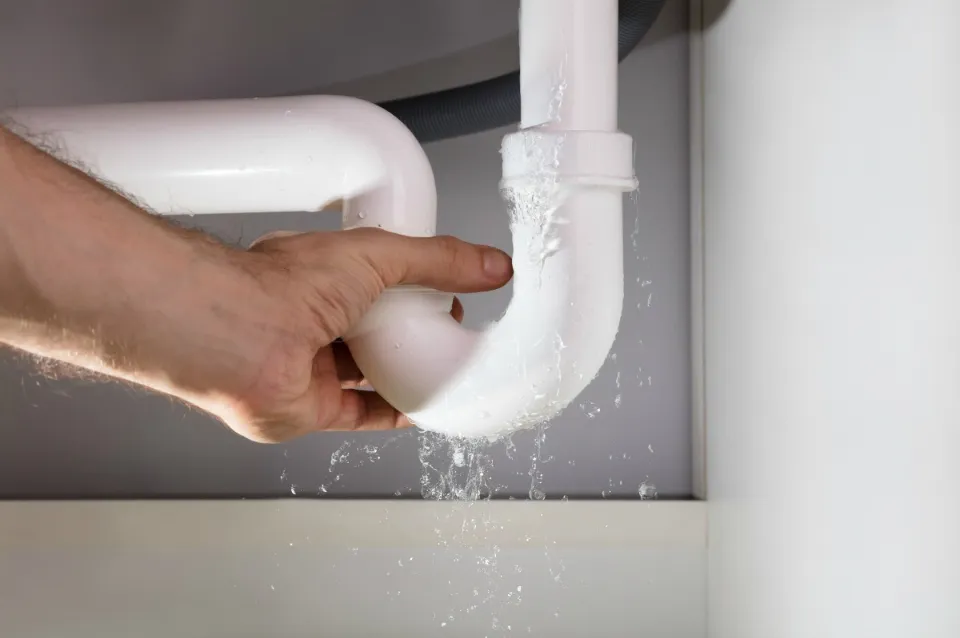
The P-trap is located inside a cabinet, typically, at the curved portion of your kitchen sink pipes. It might be necessary to clean the P-trap in your kitchen sink to unclog the obstruction.
- Put a pan or bucket underneath the drain first to catch any possible spilled water or debris.
- Then, unfasten the P-trap from the drainpipe and clear out anything that is stuck.
- The P-trap should then be replaced (ensure that all connections are made securely), and warm water should then be run through the pipes for a short time.
Tips for Preventing Clogs
Regular cleaning. Knowing how simple it is, you should clean your kitchen sink drain on a regular basis to avoid buildup and maintain functionality. Your seasonal deep clean is a great time to do this.
Go easy on the garbage disposal. Though it may be alluring to sweep food scraps into the sink and let them disappear beneath the satisfying whirr of strong blades, any plumber will tell you that a garbage disposal isn’t really designed for garbage. Things like seeds, pits, and nuts wreak havoc on filters and drains, and long peels or stringy vegetables like celery get wrapped around the blades and accelerate build-up in the drain. Keep a compost bin for food waste if you can, and use the sink for smaller items.
Don’t dispose of grease or oils in the sink. Cooking oil must be cooled completely before being transferred to a disposal container, such as a glass jar or Tupperware. You won’t be as tempted to pour it down the drain, where it coats the pipes and traps food as it passes by, resulting in a stubborn, difficult-to-dissolve buildup. Instead, save plastic delivery containers for this purpose.
Keep odors at bay. You may have heard that used coffee grounds can be routinely disposed of in the garbage disposal, but don’t. However, they can accumulate and cause clogs lower down. They may help with odor up top. A regular dose of white vinegar and baking soda, or even freshly squeezed lemon, is a much better choice.
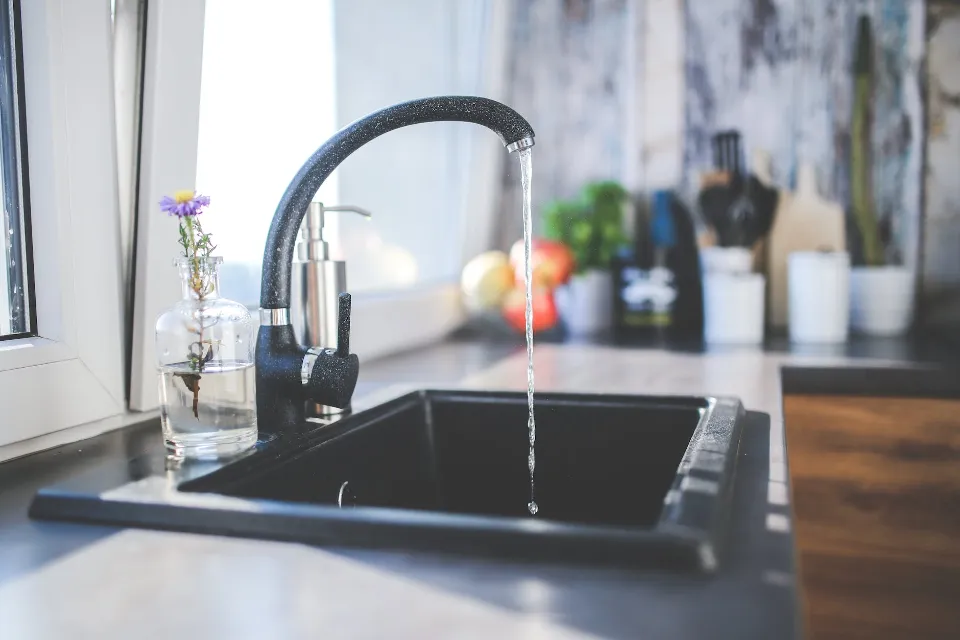
Why Do Kitchen Sink Clogs Happen in the First Place?
Food clogs the sink in the kitchen. A clog can develop in the drain or garbage disposal over time from the accumulation of all the scraped plates, crumbs, and liquids (particularly cooking oil or fat) that are poured down the drain or disposal.
You’ll know it’s time to unclog your sink when:
- The water takes longer than usual to drain
- There’s a funky odor that you can’t track down
- The sink is now full of water that is teeming with debris, and running the garbage disposal has little to no impact.
But first, unplug the garbage disposal to ensure that it is off and there is no chance of it turning back on while you are working. This will prevent you from accidentally sticking your hand down the drain to feel for it.
Read about How to Get Rid of Ants in the Kitchen?
Summary: How to Unclog a Kitchen Sink?
There are a few quick and simple techniques that work just as well without using any chemicals at all.
To start with, you need to Check the Garbage Disposal. Then, there are a few methods how to unclog a kitchen sink, such as removing the clog by hand, using a plunger, using boiling water, or using a coat hanger…
I appreciate your reading.


